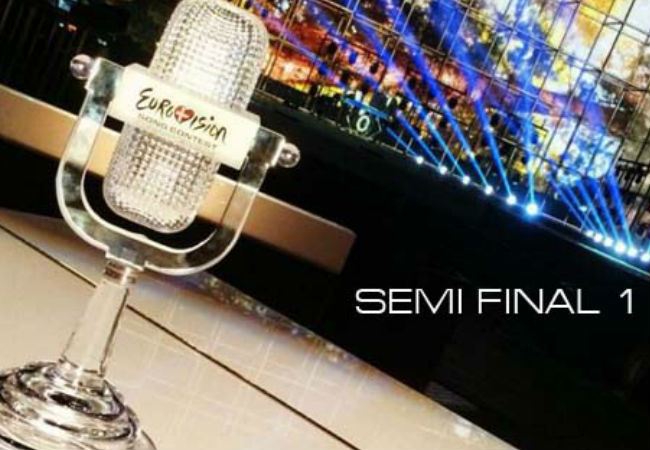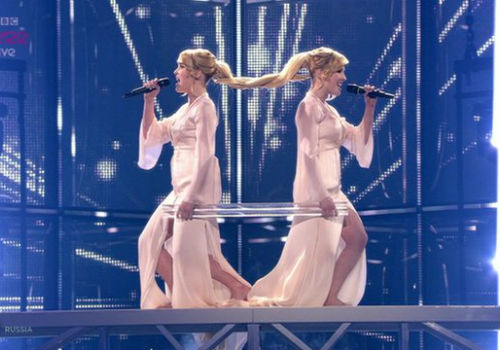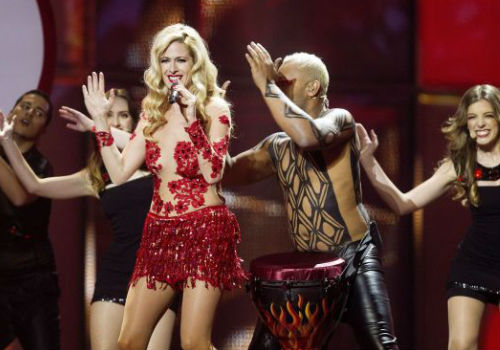
My lord, Copenhagen, is that a gigantic boat-shaped stage you have in your B&W Hallerne arena – it was a shipbuilding area so the shape of the stage was a beautifully styled nod to the building’s past life – or are you just happy to see all the wind machines, towering banks of blindingly bright LED screens and meaningfully-posed background dancers (who took interpretative dance to hitherto unseen mime-like “heights”)?
Quite possibly all of the above but whatever the mood of the state telecaster DR, which had gone all out to wow and impress the gathered throngs of the Eurovision faithful, both within the arena and without, you couldn’t possibly ignore the bright lights, big musical acts of the 16 acts competing tonight for a spot in the final.
Apart from some of the opening acts such as leading contender for this year’s Eurovision top prize, Armenia, and Latvia and Estonia sounding more than a little off key – nerves? stage fright? glitter in the throat? – everyone passed with flying colours, with Iceland’s brilliantly primary colourful and rambunctious Pollapönk, and Portugal particularly impressing with their delightfully over the top stagecraft.

No massive surprises here in terms of who made it through and who didn’t – I managed to accurately predict 7 of the 10 acts to make it through to the final, a slight improvement on last year’s 5-6 but alas no indication I am back in sync with the voting public and juries of Europe – with the final top 10 looking exactly like this (in no particular order):
1. Armenia
2. Montenegro
3. Azerbaijan
4. San Marino
5. Russia (the announcement of their final’s accession generated some sustained boos from the crowd, leaving the genial but over the top hosts more than a little non-plussed initially; they simply smiled and ignored it)
6. The Netherlands
7. Hungary
8.Ukraine
9. Iceland
10. Sweden
Two acts whose omission from the final top 10 surprised me greatly were Portugal and Estonia, both of which were armed with upbeat songs of entirely different styles, impressive performances (although Tanja from Estonia was obviously offkey for parts of her song unfortunately) and an obvious comfort being on the giant stage.
While only Suzy from Portugal effectively used the stage to maximum effect with waves of her country’s national colours washing from the stop of the screens to the tip of the stage throughout her performance, with Tanja opting for white-on-white shoeless “Euphoria”-like minimalism, they both made a distinct impression and deserved to get through.

However accomplished though they may have been, they were likely undone by top notch, vocally spot on performances by the likes of Sweden’s Sanna Nielsen, Azerbaijan’s Dilara Kazimova and Montenegro’s Sergej Ćetković, all of whom brought their A-games, to use an un-Eurovision-like sporting analogy, to semi final 1.
While the accession of so many ballad-oriented songs may have suggested that the conservative jury votes had triumphed over the popular vote once again – a common complaint from 2013’s contest – the fact that most un-ballad-like Pollapönk danced and sang their exuberant northern European Wiggles-like way into the final suggests that Europe’s love of the upbeat and the quirky is not dead and buried just yet.
And the surprise inclusion of The Netherlands, whose representative act The Common Linnets came to town with a refined country sound and a masterfully understated performance that clearly impressed more than a few people, showed that musical diversity is alive and well and beating hard within the heart of the Eurovision Song Contest.
Add in the genial if over-enthusiastic hosts for the night – Nikolaj Koppel, Lise Rønne and Pilou Asbæk – the thoroughly inventive “postcards” that announce each artist (Sweden used yellow li-los against a bright blue pool; Montenegro a jigsaw puzzle of their flag’s colours on a grand piano), the imaginative performance of last year’s winning song “Raindrops” by Emmelie de Forest using online-contributions from people around the world, and a sense of visual shock and awe from a stage that seem to soar to the heavens and need sunglasses to gaze upon it, and semi final 1 for the Eurovision Song Contest 2014 largely played out as expected.
Although the fact that Europe and I are still not musically simpatico does still pain me greatly …